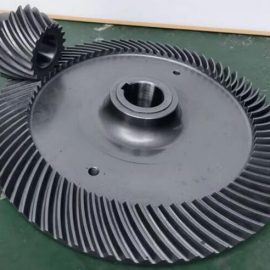Vacuum Pressure Impregnation System For Graphite Electrode
1.Why should the graphite electrode be impregnated with vacuum pressure?
Impregnation in a carbon plant is often called “immersion”.This is a product placed in a high pressure autoclaves at a certain temperature and pressure so that some liquid state of the material (macerating agent or called fufu agent) into the product pores, so as to improve or change some of the physical and chemical properties of the product.
All kinds of graphite electrode are made of different kinds of coke or coal particles as aggregate and coal asphalt as binder.After pressure molding, the porosity of raw products is very low.However, after roasting the raw products, part of the coal pitch is decomposed into gas and escapes in the roasting process, while the other part is coking into asphalt coke.
Generally speaking, the hole of the product increases, the false specific gravity (density) decreases, the specific resistance increases, the mechanical strength decreases, the oxidation speed at a certain temperature speeds up, the corrosion resistance also becomes bad, the gas or liquid is more easily permeable.Immersion (or immersion) is a process that reduces the porosity of a product and improves its quality.


2. The key parameters of the impregnation process
(1)Vacuum impregnation
Through Hangzhou Ruiqin Mechanical Equipment Co.,Ltd model RQ-VPI-2220 vacuum pressure impregnating equipment in the impregnating process of the workpiece in the impregnating pot to remove the air in the pores of the graphite workpiece, the cleaner the removal, the more conducive to the infiltration of the impregnated resin, the depth of resin penetration and weight gain rate after impregnation is determined by the vacuum degree.This is true whether the impregnating agent is phenolic, furan or PTFE. It is important, therefore, that the vacuum impregnation be greater than 700mm Hg in the impregnation procedure.
(2)Applied pressure during impregnation
The purpose of this pressure is to boost the penetration depth of the resin, so a pressure greater than or equal to 0.5 Mpa is required.However, the pressure requirement of foreign single-dip impregnation process is greater than 0.6 Mpa.
(3)Applied pressure in the heat treatment process
Heat treatment is to penetrate completely curing of resin impregnated graphite artifacts internal, its pressure aimed at preventing the leftover in the process of heating in the graphite artifacts pore air, along with the rise of temperature, cause pore immersed in resin of escape, and if not exert. External pressure, immersed in resin viscosity with temperature and lower and flush out.So apply An external pressure of 0.5MPa is required.
(4) Heating curve of heat treatment
When impregnating with tawny resin, the maximum heat treatment temperature and holding time at high temperature should be higher or extended to 20-25 hours (referred to furfuryl ketone) or 10-15 hours (referred to furfuryl alcohol) than phenolic resin.However, in practice, reasonable curing agent can reduce the insulation time.
The setting of impregnation curve should be paid attention to, not only in the maximum heat treatment temperature and high temperature holding time, but also in the heating rate at the stage of 50~80 ° c, too fast will cause the free water and small water molecules in the impregnation resin to fully escape, otherwise it will cause defects such as bubbles on the surface of the resin after curing.
(5) The surface state of graphite work-piece
The oil and impurities on the work-piece surface should be removed before macerating, and the remaining resin on the work-piece surface should be removed after macerating, otherwise the extra resin will affect the next macerating effect.
(6) Graphite raw material
The hole of the most raw material of adding fruit stone is limited and concentrated, after conventional maceration, leakage will still occur.The Times of impregnation need to be increased and the strength of graphite will be reduced.
3.The quality of the impregnation test.
3.1 Test of impregnated resin: its technical indicators shall comply with the provisions in table 3 (take phenolic resin as an example), and the following items shall be tested (take phenolic resin as an example):
(1) Content of free phenol in phenolic resin
According to HG/ T5-1342-1980
(2) Content of free aldehyde in phenolic resin
According to HG/T2622-1994
(3) Water content in phenolic resin
According to provisions of HG/T5-1341-1980
(4) Polymerization degree test of phenolic resin
According to HG/ T5-1338-1980
(5) Viscosity test of phenolic resin
According to HG/ T5-1340-1980
3.2 The weight gain and hole filling rate of impregnated graphite shall be measured in accordance with the corresponding standard control indexes, according to the HG/T2060-1991 method
3.3 Water pressure test of impervious graphite tube
According to HG/ T2381-1992, or according to the design pressure 1.5 times of water pressure for 10 minutes, to no leakage as qualified.
3.4 The graphite components of a hole graphite heat exchanger shall be pressurized at 1.5 times the designed pressure and kept for 10 minutes before assembly so as not to leak.

40Cr Steel Quenching And Tempering Treatment Process Nitriding Furnace Safety Operation Rules Analysis Of Common Problems In Carburizing And Nitriding


Contact us
Your email address will not be published. Required fields are marked *